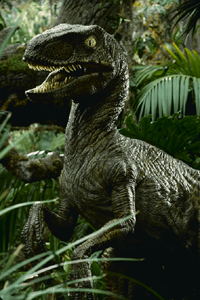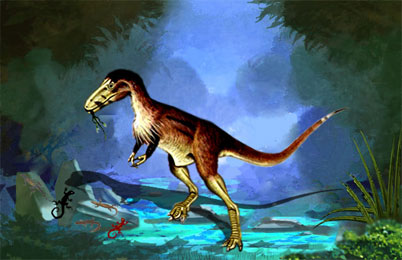Dinosaur Eggs
Dinosaurs reproduced by laying eggs. Some dinosaurs seem to have laid their eggs and then left them, whereas others seem to have incubuated their eggs and looked after their young in a similar way to modern birds. We know about this behavior because scientists have found fossilized dinosaur eggs, and of dinosaur nests:
 A Fossilized Dinosaur Egg, Probably of the Sauropod Hypselosaurus Giclee Print Buy at AllPosters.com |
- Fossilized eggs of Camarasaurus have been found arranged in lines (and not in nest). From this evidence, scientists believe that Camarasaurus, did not tend to their young. It is also thought like that neither did other Sauropod dinosaurs.
- In the case of another Sauropod dinosaur, Saltasaurus, hundreds of eggs (which must have been from many different females) were found buried together. From this it is thought that the animal must have lived in herds. The burying of many eggs together would have probably have increased the hatchling's chances of survival.
- The eggs and nests of Protoceratops were the first dinosaur eggs and nests found. In the case of Protoceratops, the eggs were carefully laid in spirals, with upto 18 eggs in each nest.
- When Maiasaura nests and eggs were found (in 1978 by "Jack" Horner and Robert Makela), they were found to be mounds of mud, with a depression in the center, and each containing 30 to 40 eggs. Although Maiasaura is not thought to have sat on its nests (instead the eggs would have been incubated by the heat from rotting vegetation), it is thought that Maiasaura did tend to its young: Baby Maiasaura hatchlings have been found which were incapable of walking but nevertheless had worn teeth - indicating that adults must have brought food to the nest.
- Massospondylus eggs also suggest that this dinosaur cared for its young. In the case of Massospondylus, eggs near to hatching have been found, and these suggest that the hatchlings would have been born with no teeth and incapable of feeding themselves - indicating that the parents must have tended to their young.
- A number of different dinosaurs have been characterized as probably eating other dinosaur's eggs. These include Chirostenotes, Gallimimus, Ornithomimus, and Oviraptor. In the case of Oviraptor, this may be a particularly unfair characterization (which is especially ironic given that its name means "egg thief"), since there is good evidence that Oviraptor nested and cared for its own eggs - and thus the nest and eggs it has been found close to, may have been its own.
aublysodon Dinosaur | ||||||
| The Aublysodon is a carnivorous dinosaur. Even before the badlands of North America started enlightening the bones of Tyrannosaurus rex, many paleontologists from the late nineteenth century decided that long, pointed teeth turning up in many localities in the Western United States belonged to the deadliest, most ferocious dinosaurs that ever lived. Problematically, at this time, many dinosaur taxons were named for isolated teeth; such genera include Trachodon, Paleoscincus, and Troodon. Scientists named are particular taxon Aublysodon. Since then, over a dozen type of this supposedly fearsome theropod have been described. | ||||||
| | ||||||
| As with some other theropods, many paleontologists no longer use Aublysodo as a valid genus. It is now extensively considered to be just a juvenile Tyrannosaurus rex, due to longer teeth and larger eyes characteristic of younger specimens of that species. | ||||||
| Aublysodon facts: | ||||||
| ||||||
The term 'dinosaur' originates from the Greek words deino and sauros, meaning 'terrible' and 'lizard'.Sir Richard Owen invented the name 'dinosaur' in 1842, to describe an extinct group of terrestrial reptiles that lived during the Mesozoic. At that time, he had only three or four dinosaur skeletons to consider, but many hundreds more have been found since 1842.
Dinosaurs show a range of adaptations to a wide range of environments and conditions, and as a result they became the most successful land animals of all time.Dinosaurs are animals that dominated the terrestrial ecosystem for over 100-million years. Non-avian dinosaurs became extinct 65 million years ago (Mya) at the end of the Cretaceous period.
Dinosaurs are known from both fossils and nonfossils including fossilized bones, feces, trackways, gastroliths, feathers, impressions of skin and internal organs, and "soft tissues, including blood vessels and cells lining them. Since the first dinosaur was recognized in the 19th century, their mounted.

 The first post-dentary remains of Aublysodon were a partial skull unearthed in Montana in the 1980s. The skull bore the same pointed teeth attached to a long tapered skull the length of an average human arm. This adaption resembles that of theropods designed for eating fish. Famous dinosaurologist and paleoartist
The first post-dentary remains of Aublysodon were a partial skull unearthed in Montana in the 1980s. The skull bore the same pointed teeth attached to a long tapered skull the length of an average human arm. This adaption resembles that of theropods designed for eating fish. Famous dinosaurologist and paleoartist
No comments:
Post a Comment